Organizations and Behavior: CAPCO and Leadership Report
VerifiedAdded on 2020/02/05
|18
|5332
|39
Report
AI Summary
This report examines CAPCO (Capital Markets Company), a technology and business consultancy, focusing on its organizational behavior, structure, and culture. It compares CAPCO's flat structure and team-based culture with other organizations, analyzing their impact on performance. The report discusses factors influencing individual behavior, different leadership styles, and the application of management theories. It also explores the influence of leadership styles on motivation during change, compares motivation theories, and emphasizes the importance of understanding and applying these theories in the workplace. Furthermore, the report analyzes group behavior, factors affecting teamwork, and the impact of technology on team functioning within CAPCO. The analysis highlights how CAPCO's innovative approaches to management, employee empowerment, and emphasis on knowledge-sharing contribute to its success in the financial services industry.
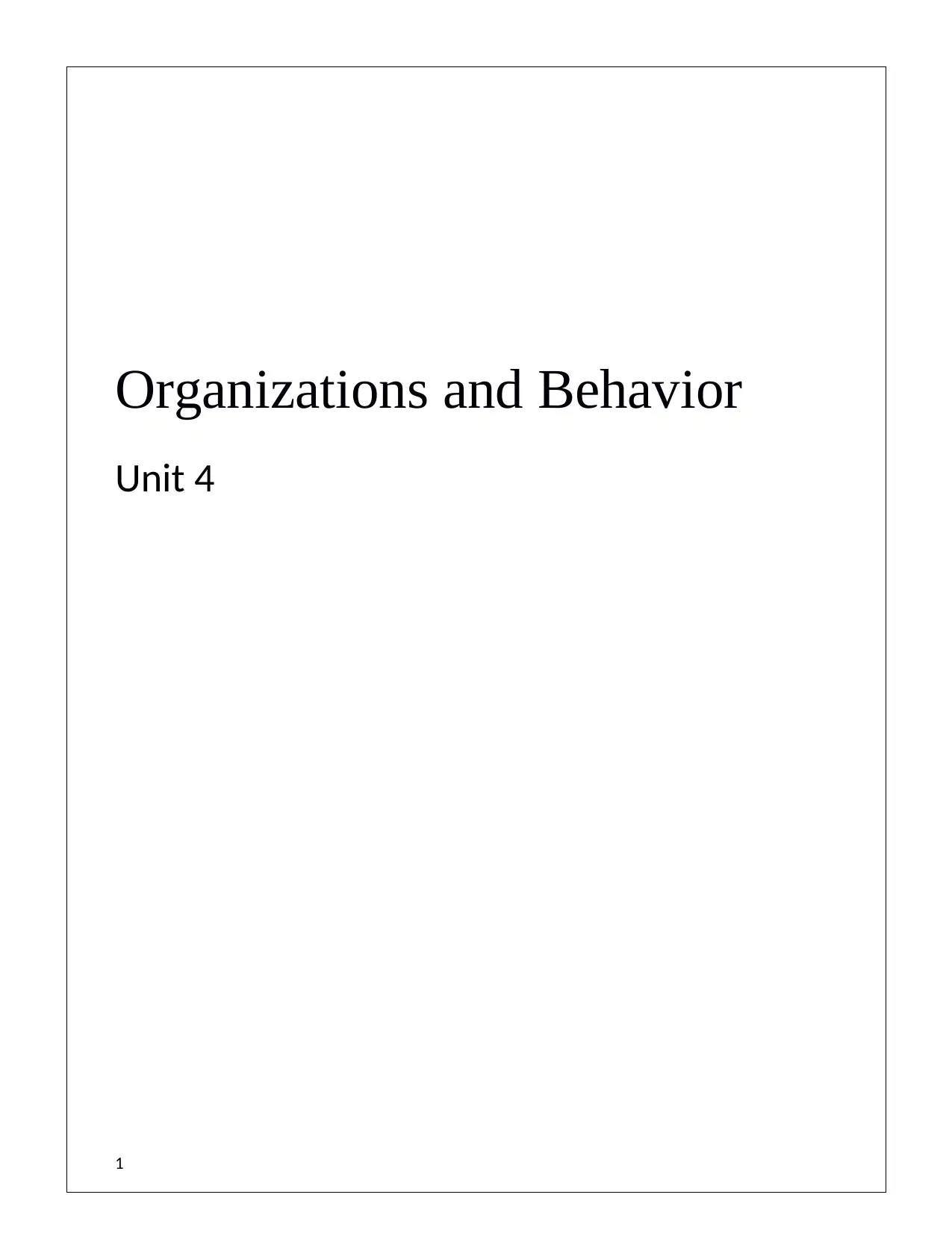
Organizations and Behavior
Unit 4
1
Unit 4
1
Paraphrase This Document
Need a fresh take? Get an instant paraphrase of this document with our AI Paraphraser
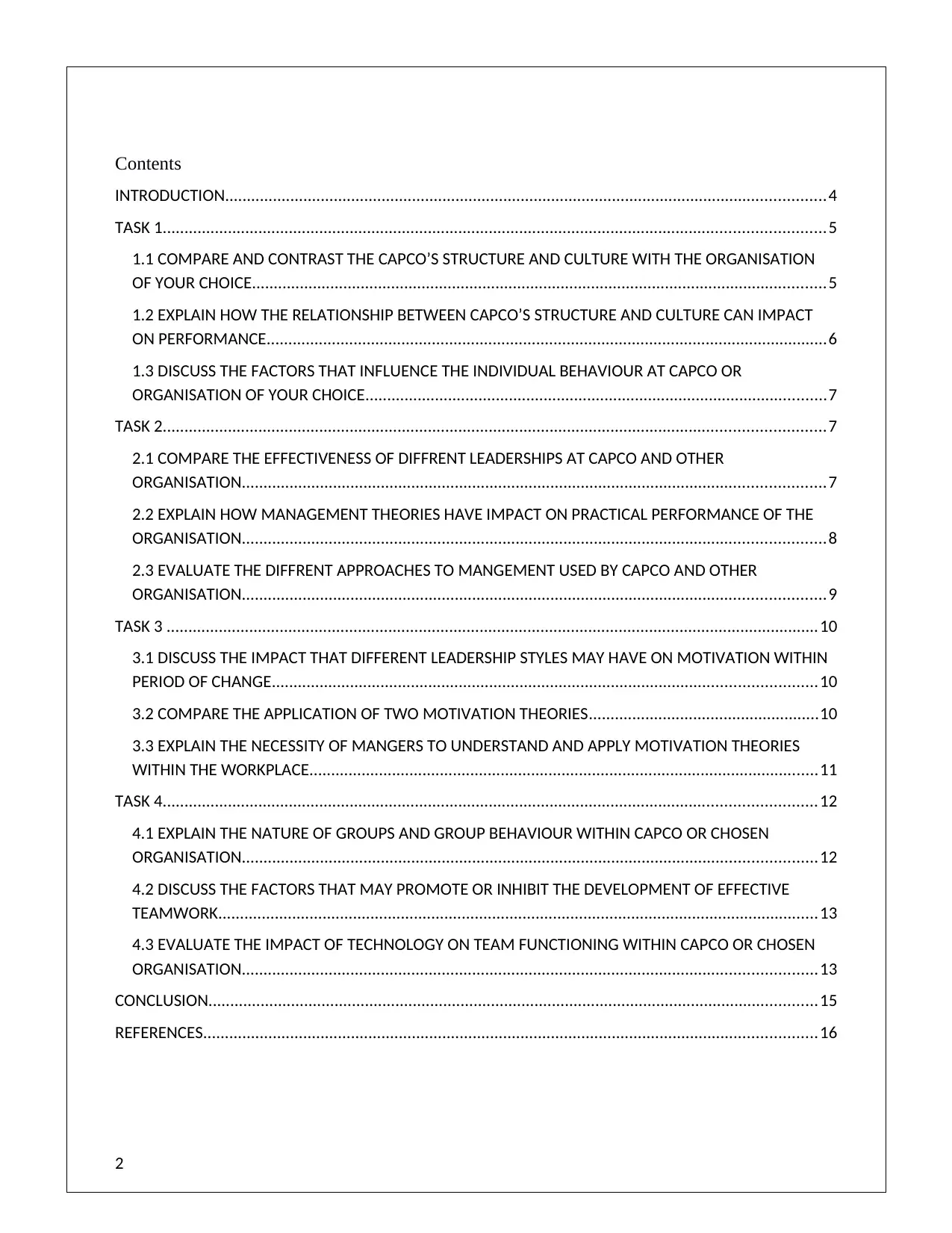
Contents
INTRODUCTION..........................................................................................................................................4
TASK 1........................................................................................................................................................5
1.1 COMPARE AND CONTRAST THE CAPCO’S STRUCTURE AND CULTURE WITH THE ORGANISATION
OF YOUR CHOICE....................................................................................................................................5
1.2 EXPLAIN HOW THE RELATIONSHIP BETWEEN CAPCO’S STRUCTURE AND CULTURE CAN IMPACT
ON PERFORMANCE.................................................................................................................................6
1.3 DISCUSS THE FACTORS THAT INFLUENCE THE INDIVIDUAL BEHAVIOUR AT CAPCO OR
ORGANISATION OF YOUR CHOICE..........................................................................................................7
TASK 2........................................................................................................................................................7
2.1 COMPARE THE EFFECTIVENESS OF DIFFRENT LEADERSHIPS AT CAPCO AND OTHER
ORGANISATION......................................................................................................................................7
2.2 EXPLAIN HOW MANAGEMENT THEORIES HAVE IMPACT ON PRACTICAL PERFORMANCE OF THE
ORGANISATION......................................................................................................................................8
2.3 EVALUATE THE DIFFRENT APPROACHES TO MANGEMENT USED BY CAPCO AND OTHER
ORGANISATION......................................................................................................................................9
TASK 3 ......................................................................................................................................................10
3.1 DISCUSS THE IMPACT THAT DIFFERENT LEADERSHIP STYLES MAY HAVE ON MOTIVATION WITHIN
PERIOD OF CHANGE.............................................................................................................................10
3.2 COMPARE THE APPLICATION OF TWO MOTIVATION THEORIES.....................................................10
3.3 EXPLAIN THE NECESSITY OF MANGERS TO UNDERSTAND AND APPLY MOTIVATION THEORIES
WITHIN THE WORKPLACE.....................................................................................................................11
TASK 4......................................................................................................................................................12
4.1 EXPLAIN THE NATURE OF GROUPS AND GROUP BEHAVIOUR WITHIN CAPCO OR CHOSEN
ORGANISATION....................................................................................................................................12
4.2 DISCUSS THE FACTORS THAT MAY PROMOTE OR INHIBIT THE DEVELOPMENT OF EFFECTIVE
TEAMWORK..........................................................................................................................................13
4.3 EVALUATE THE IMPACT OF TECHNOLOGY ON TEAM FUNCTIONING WITHIN CAPCO OR CHOSEN
ORGANISATION....................................................................................................................................13
CONCLUSION............................................................................................................................................15
REFERENCES.............................................................................................................................................16
2
INTRODUCTION..........................................................................................................................................4
TASK 1........................................................................................................................................................5
1.1 COMPARE AND CONTRAST THE CAPCO’S STRUCTURE AND CULTURE WITH THE ORGANISATION
OF YOUR CHOICE....................................................................................................................................5
1.2 EXPLAIN HOW THE RELATIONSHIP BETWEEN CAPCO’S STRUCTURE AND CULTURE CAN IMPACT
ON PERFORMANCE.................................................................................................................................6
1.3 DISCUSS THE FACTORS THAT INFLUENCE THE INDIVIDUAL BEHAVIOUR AT CAPCO OR
ORGANISATION OF YOUR CHOICE..........................................................................................................7
TASK 2........................................................................................................................................................7
2.1 COMPARE THE EFFECTIVENESS OF DIFFRENT LEADERSHIPS AT CAPCO AND OTHER
ORGANISATION......................................................................................................................................7
2.2 EXPLAIN HOW MANAGEMENT THEORIES HAVE IMPACT ON PRACTICAL PERFORMANCE OF THE
ORGANISATION......................................................................................................................................8
2.3 EVALUATE THE DIFFRENT APPROACHES TO MANGEMENT USED BY CAPCO AND OTHER
ORGANISATION......................................................................................................................................9
TASK 3 ......................................................................................................................................................10
3.1 DISCUSS THE IMPACT THAT DIFFERENT LEADERSHIP STYLES MAY HAVE ON MOTIVATION WITHIN
PERIOD OF CHANGE.............................................................................................................................10
3.2 COMPARE THE APPLICATION OF TWO MOTIVATION THEORIES.....................................................10
3.3 EXPLAIN THE NECESSITY OF MANGERS TO UNDERSTAND AND APPLY MOTIVATION THEORIES
WITHIN THE WORKPLACE.....................................................................................................................11
TASK 4......................................................................................................................................................12
4.1 EXPLAIN THE NATURE OF GROUPS AND GROUP BEHAVIOUR WITHIN CAPCO OR CHOSEN
ORGANISATION....................................................................................................................................12
4.2 DISCUSS THE FACTORS THAT MAY PROMOTE OR INHIBIT THE DEVELOPMENT OF EFFECTIVE
TEAMWORK..........................................................................................................................................13
4.3 EVALUATE THE IMPACT OF TECHNOLOGY ON TEAM FUNCTIONING WITHIN CAPCO OR CHOSEN
ORGANISATION....................................................................................................................................13
CONCLUSION............................................................................................................................................15
REFERENCES.............................................................................................................................................16
2

3
⊘ This is a preview!⊘
Do you want full access?
Subscribe today to unlock all pages.

Trusted by 1+ million students worldwide
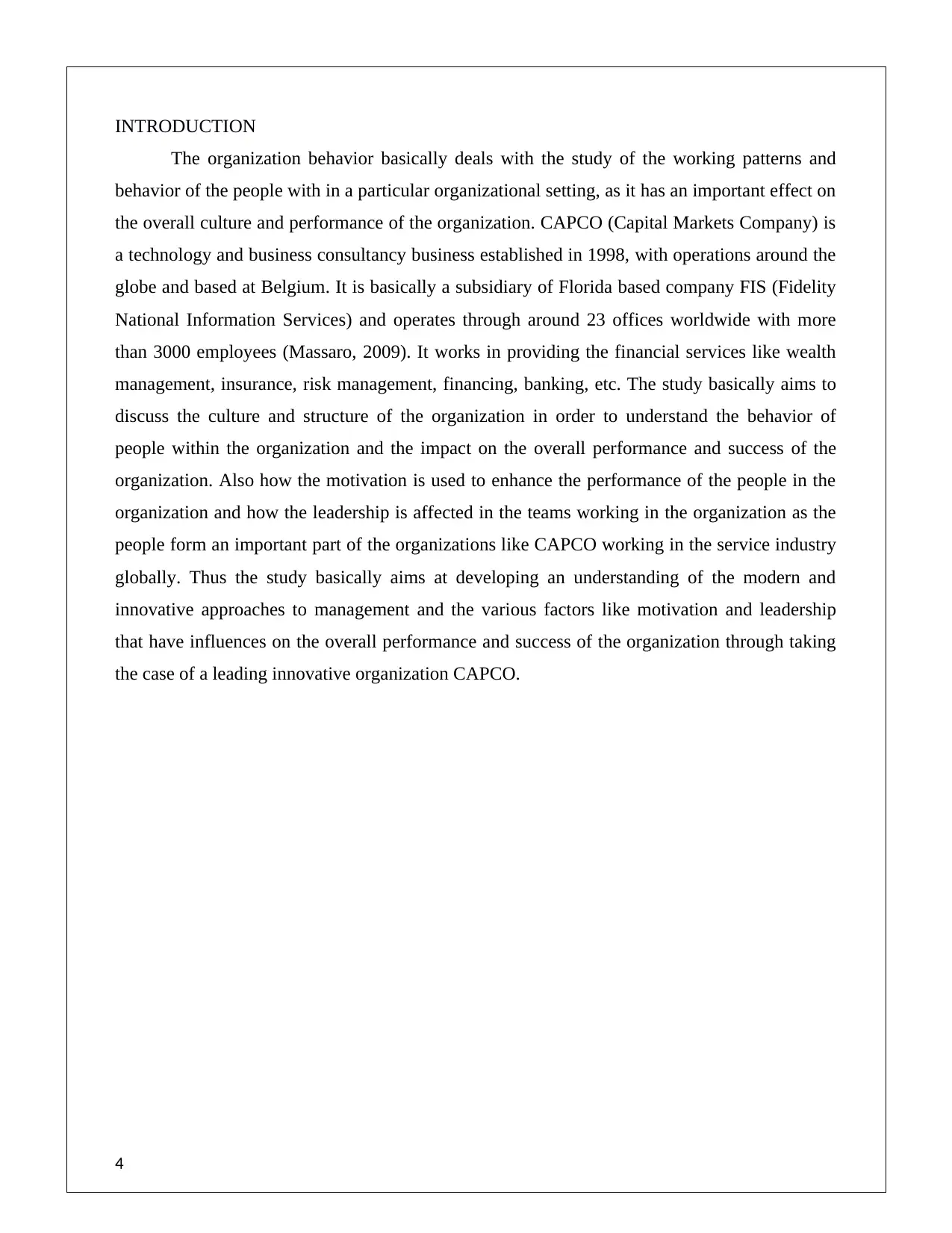
INTRODUCTION
The organization behavior basically deals with the study of the working patterns and
behavior of the people with in a particular organizational setting, as it has an important effect on
the overall culture and performance of the organization. CAPCO (Capital Markets Company) is
a technology and business consultancy business established in 1998, with operations around the
globe and based at Belgium. It is basically a subsidiary of Florida based company FIS (Fidelity
National Information Services) and operates through around 23 offices worldwide with more
than 3000 employees (Massaro, 2009). It works in providing the financial services like wealth
management, insurance, risk management, financing, banking, etc. The study basically aims to
discuss the culture and structure of the organization in order to understand the behavior of
people within the organization and the impact on the overall performance and success of the
organization. Also how the motivation is used to enhance the performance of the people in the
organization and how the leadership is affected in the teams working in the organization as the
people form an important part of the organizations like CAPCO working in the service industry
globally. Thus the study basically aims at developing an understanding of the modern and
innovative approaches to management and the various factors like motivation and leadership
that have influences on the overall performance and success of the organization through taking
the case of a leading innovative organization CAPCO.
4
The organization behavior basically deals with the study of the working patterns and
behavior of the people with in a particular organizational setting, as it has an important effect on
the overall culture and performance of the organization. CAPCO (Capital Markets Company) is
a technology and business consultancy business established in 1998, with operations around the
globe and based at Belgium. It is basically a subsidiary of Florida based company FIS (Fidelity
National Information Services) and operates through around 23 offices worldwide with more
than 3000 employees (Massaro, 2009). It works in providing the financial services like wealth
management, insurance, risk management, financing, banking, etc. The study basically aims to
discuss the culture and structure of the organization in order to understand the behavior of
people within the organization and the impact on the overall performance and success of the
organization. Also how the motivation is used to enhance the performance of the people in the
organization and how the leadership is affected in the teams working in the organization as the
people form an important part of the organizations like CAPCO working in the service industry
globally. Thus the study basically aims at developing an understanding of the modern and
innovative approaches to management and the various factors like motivation and leadership
that have influences on the overall performance and success of the organization through taking
the case of a leading innovative organization CAPCO.
4
Paraphrase This Document
Need a fresh take? Get an instant paraphrase of this document with our AI Paraphraser
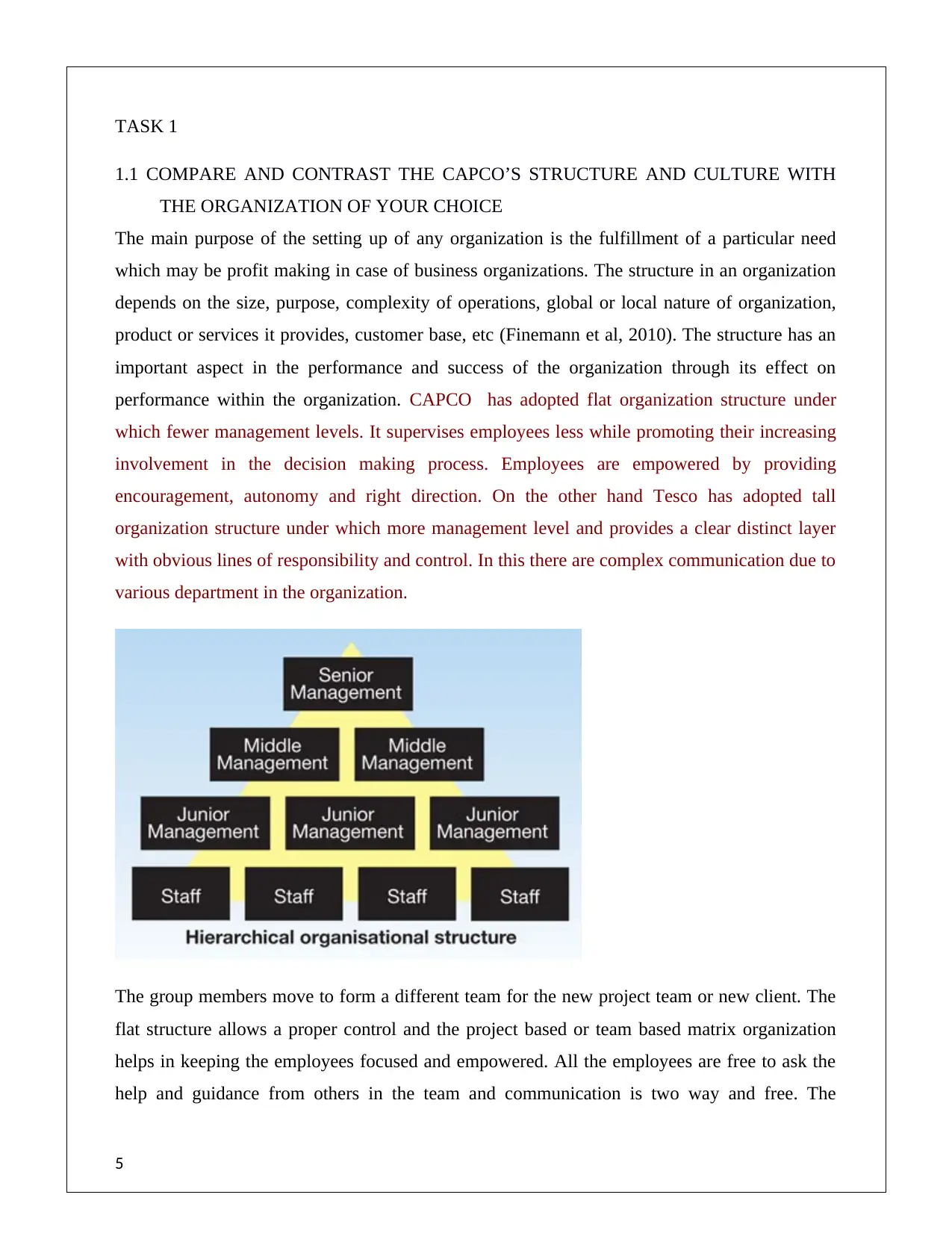
TASK 1
1.1 COMPARE AND CONTRAST THE CAPCO’S STRUCTURE AND CULTURE WITH
THE ORGANIZATION OF YOUR CHOICE
The main purpose of the setting up of any organization is the fulfillment of a particular need
which may be profit making in case of business organizations. The structure in an organization
depends on the size, purpose, complexity of operations, global or local nature of organization,
product or services it provides, customer base, etc (Finemann et al, 2010). The structure has an
important aspect in the performance and success of the organization through its effect on
performance within the organization. CAPCO has adopted flat organization structure under
which fewer management levels. It supervises employees less while promoting their increasing
involvement in the decision making process. Employees are empowered by providing
encouragement, autonomy and right direction. On the other hand Tesco has adopted tall
organization structure under which more management level and provides a clear distinct layer
with obvious lines of responsibility and control. In this there are complex communication due to
various department in the organization.
The group members move to form a different team for the new project team or new client. The
flat structure allows a proper control and the project based or team based matrix organization
helps in keeping the employees focused and empowered. All the employees are free to ask the
help and guidance from others in the team and communication is two way and free. The
5
1.1 COMPARE AND CONTRAST THE CAPCO’S STRUCTURE AND CULTURE WITH
THE ORGANIZATION OF YOUR CHOICE
The main purpose of the setting up of any organization is the fulfillment of a particular need
which may be profit making in case of business organizations. The structure in an organization
depends on the size, purpose, complexity of operations, global or local nature of organization,
product or services it provides, customer base, etc (Finemann et al, 2010). The structure has an
important aspect in the performance and success of the organization through its effect on
performance within the organization. CAPCO has adopted flat organization structure under
which fewer management levels. It supervises employees less while promoting their increasing
involvement in the decision making process. Employees are empowered by providing
encouragement, autonomy and right direction. On the other hand Tesco has adopted tall
organization structure under which more management level and provides a clear distinct layer
with obvious lines of responsibility and control. In this there are complex communication due to
various department in the organization.
The group members move to form a different team for the new project team or new client. The
flat structure allows a proper control and the project based or team based matrix organization
helps in keeping the employees focused and empowered. All the employees are free to ask the
help and guidance from others in the team and communication is two way and free. The
5
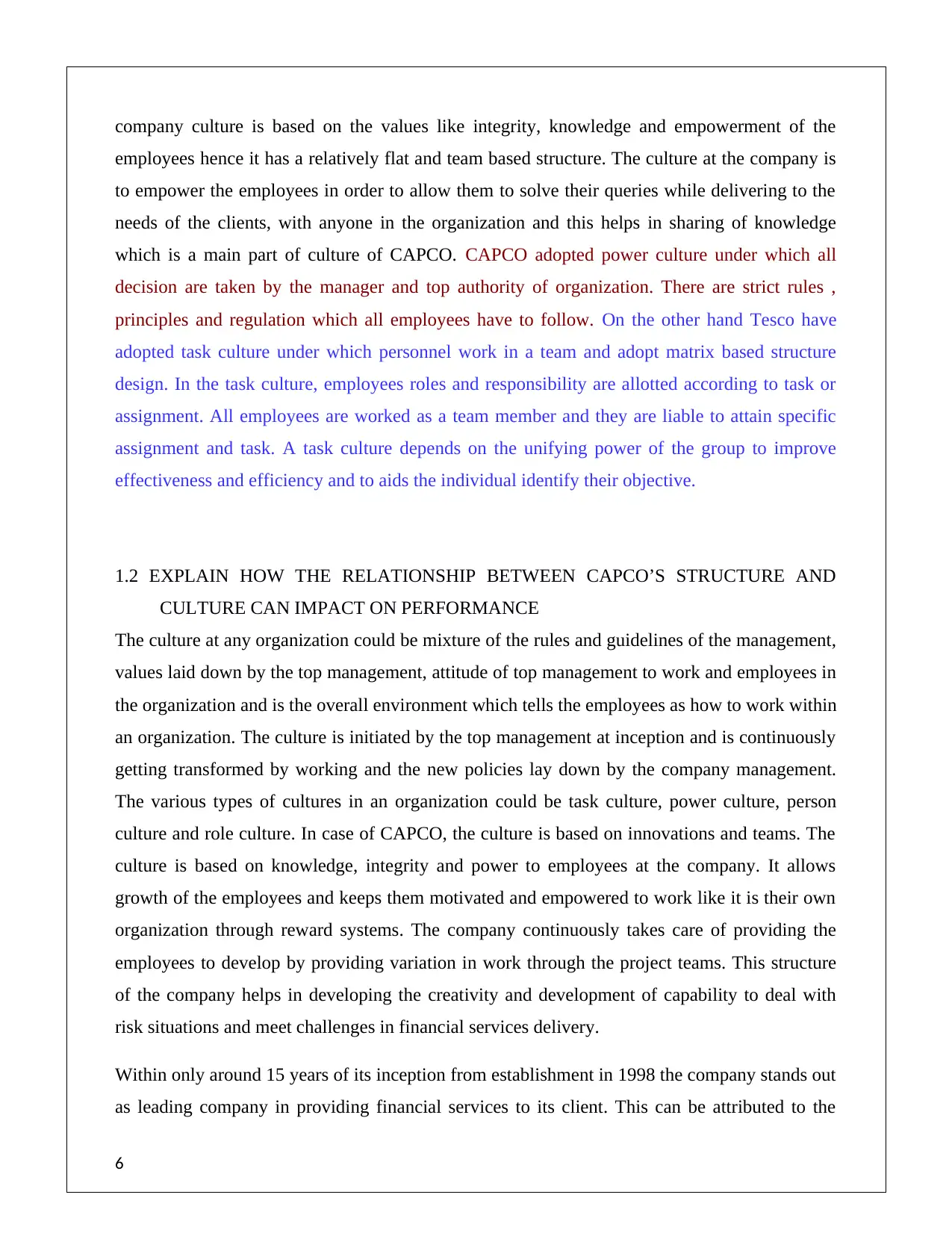
company culture is based on the values like integrity, knowledge and empowerment of the
employees hence it has a relatively flat and team based structure. The culture at the company is
to empower the employees in order to allow them to solve their queries while delivering to the
needs of the clients, with anyone in the organization and this helps in sharing of knowledge
which is a main part of culture of CAPCO. CAPCO adopted power culture under which all
decision are taken by the manager and top authority of organization. There are strict rules ,
principles and regulation which all employees have to follow. On the other hand Tesco have
adopted task culture under which personnel work in a team and adopt matrix based structure
design. In the task culture, employees roles and responsibility are allotted according to task or
assignment. All employees are worked as a team member and they are liable to attain specific
assignment and task. A task culture depends on the unifying power of the group to improve
effectiveness and efficiency and to aids the individual identify their objective.
1.2 EXPLAIN HOW THE RELATIONSHIP BETWEEN CAPCO’S STRUCTURE AND
CULTURE CAN IMPACT ON PERFORMANCE
The culture at any organization could be mixture of the rules and guidelines of the management,
values laid down by the top management, attitude of top management to work and employees in
the organization and is the overall environment which tells the employees as how to work within
an organization. The culture is initiated by the top management at inception and is continuously
getting transformed by working and the new policies lay down by the company management.
The various types of cultures in an organization could be task culture, power culture, person
culture and role culture. In case of CAPCO, the culture is based on innovations and teams. The
culture is based on knowledge, integrity and power to employees at the company. It allows
growth of the employees and keeps them motivated and empowered to work like it is their own
organization through reward systems. The company continuously takes care of providing the
employees to develop by providing variation in work through the project teams. This structure
of the company helps in developing the creativity and development of capability to deal with
risk situations and meet challenges in financial services delivery.
Within only around 15 years of its inception from establishment in 1998 the company stands out
as leading company in providing financial services to its client. This can be attributed to the
6
employees hence it has a relatively flat and team based structure. The culture at the company is
to empower the employees in order to allow them to solve their queries while delivering to the
needs of the clients, with anyone in the organization and this helps in sharing of knowledge
which is a main part of culture of CAPCO. CAPCO adopted power culture under which all
decision are taken by the manager and top authority of organization. There are strict rules ,
principles and regulation which all employees have to follow. On the other hand Tesco have
adopted task culture under which personnel work in a team and adopt matrix based structure
design. In the task culture, employees roles and responsibility are allotted according to task or
assignment. All employees are worked as a team member and they are liable to attain specific
assignment and task. A task culture depends on the unifying power of the group to improve
effectiveness and efficiency and to aids the individual identify their objective.
1.2 EXPLAIN HOW THE RELATIONSHIP BETWEEN CAPCO’S STRUCTURE AND
CULTURE CAN IMPACT ON PERFORMANCE
The culture at any organization could be mixture of the rules and guidelines of the management,
values laid down by the top management, attitude of top management to work and employees in
the organization and is the overall environment which tells the employees as how to work within
an organization. The culture is initiated by the top management at inception and is continuously
getting transformed by working and the new policies lay down by the company management.
The various types of cultures in an organization could be task culture, power culture, person
culture and role culture. In case of CAPCO, the culture is based on innovations and teams. The
culture is based on knowledge, integrity and power to employees at the company. It allows
growth of the employees and keeps them motivated and empowered to work like it is their own
organization through reward systems. The company continuously takes care of providing the
employees to develop by providing variation in work through the project teams. This structure
of the company helps in developing the creativity and development of capability to deal with
risk situations and meet challenges in financial services delivery.
Within only around 15 years of its inception from establishment in 1998 the company stands out
as leading company in providing financial services to its client. This can be attributed to the
6
⊘ This is a preview!⊘
Do you want full access?
Subscribe today to unlock all pages.

Trusted by 1+ million students worldwide
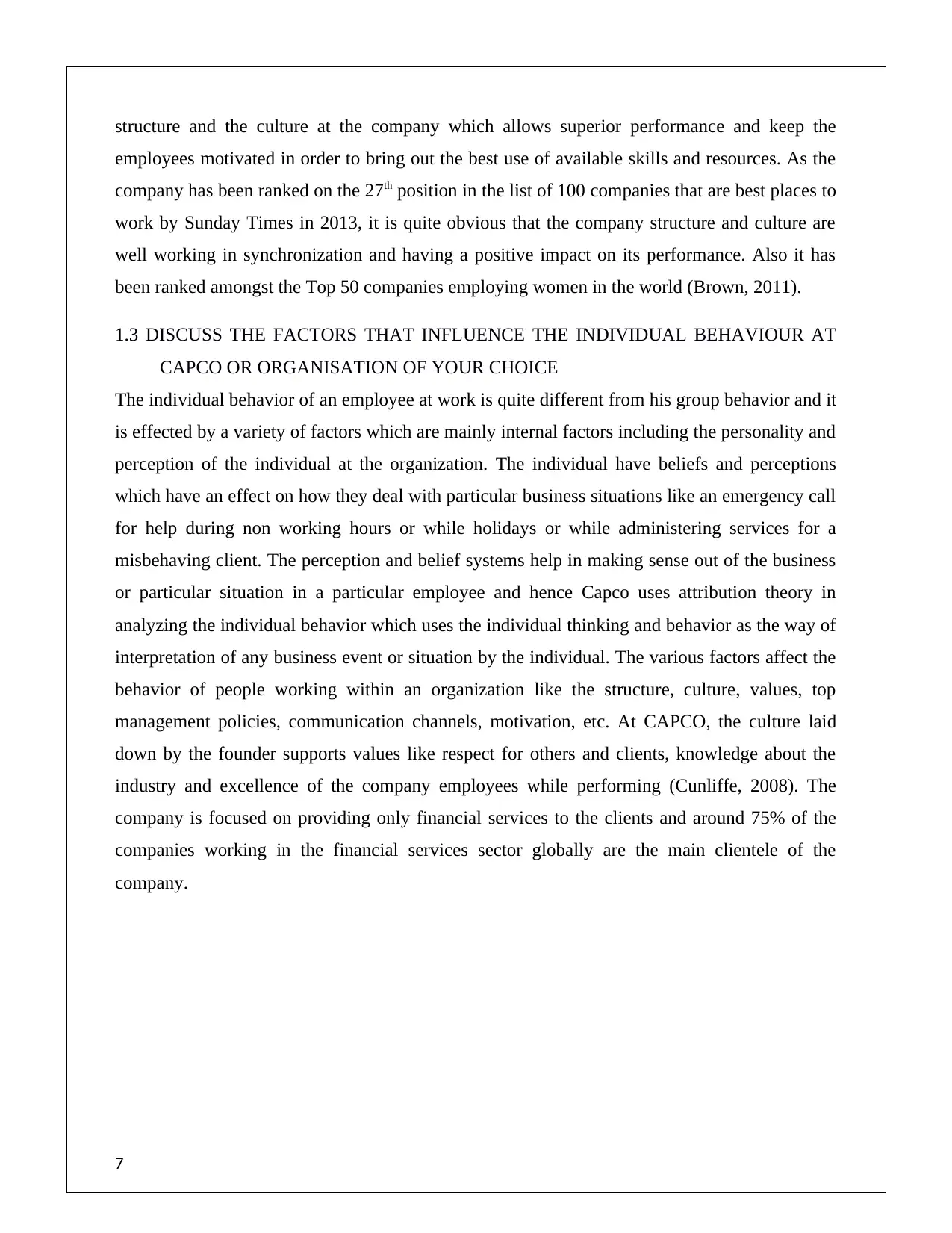
structure and the culture at the company which allows superior performance and keep the
employees motivated in order to bring out the best use of available skills and resources. As the
company has been ranked on the 27th position in the list of 100 companies that are best places to
work by Sunday Times in 2013, it is quite obvious that the company structure and culture are
well working in synchronization and having a positive impact on its performance. Also it has
been ranked amongst the Top 50 companies employing women in the world (Brown, 2011).
1.3 DISCUSS THE FACTORS THAT INFLUENCE THE INDIVIDUAL BEHAVIOUR AT
CAPCO OR ORGANISATION OF YOUR CHOICE
The individual behavior of an employee at work is quite different from his group behavior and it
is effected by a variety of factors which are mainly internal factors including the personality and
perception of the individual at the organization. The individual have beliefs and perceptions
which have an effect on how they deal with particular business situations like an emergency call
for help during non working hours or while holidays or while administering services for a
misbehaving client. The perception and belief systems help in making sense out of the business
or particular situation in a particular employee and hence Capco uses attribution theory in
analyzing the individual behavior which uses the individual thinking and behavior as the way of
interpretation of any business event or situation by the individual. The various factors affect the
behavior of people working within an organization like the structure, culture, values, top
management policies, communication channels, motivation, etc. At CAPCO, the culture laid
down by the founder supports values like respect for others and clients, knowledge about the
industry and excellence of the company employees while performing (Cunliffe, 2008). The
company is focused on providing only financial services to the clients and around 75% of the
companies working in the financial services sector globally are the main clientele of the
company.
7
employees motivated in order to bring out the best use of available skills and resources. As the
company has been ranked on the 27th position in the list of 100 companies that are best places to
work by Sunday Times in 2013, it is quite obvious that the company structure and culture are
well working in synchronization and having a positive impact on its performance. Also it has
been ranked amongst the Top 50 companies employing women in the world (Brown, 2011).
1.3 DISCUSS THE FACTORS THAT INFLUENCE THE INDIVIDUAL BEHAVIOUR AT
CAPCO OR ORGANISATION OF YOUR CHOICE
The individual behavior of an employee at work is quite different from his group behavior and it
is effected by a variety of factors which are mainly internal factors including the personality and
perception of the individual at the organization. The individual have beliefs and perceptions
which have an effect on how they deal with particular business situations like an emergency call
for help during non working hours or while holidays or while administering services for a
misbehaving client. The perception and belief systems help in making sense out of the business
or particular situation in a particular employee and hence Capco uses attribution theory in
analyzing the individual behavior which uses the individual thinking and behavior as the way of
interpretation of any business event or situation by the individual. The various factors affect the
behavior of people working within an organization like the structure, culture, values, top
management policies, communication channels, motivation, etc. At CAPCO, the culture laid
down by the founder supports values like respect for others and clients, knowledge about the
industry and excellence of the company employees while performing (Cunliffe, 2008). The
company is focused on providing only financial services to the clients and around 75% of the
companies working in the financial services sector globally are the main clientele of the
company.
7
Paraphrase This Document
Need a fresh take? Get an instant paraphrase of this document with our AI Paraphraser
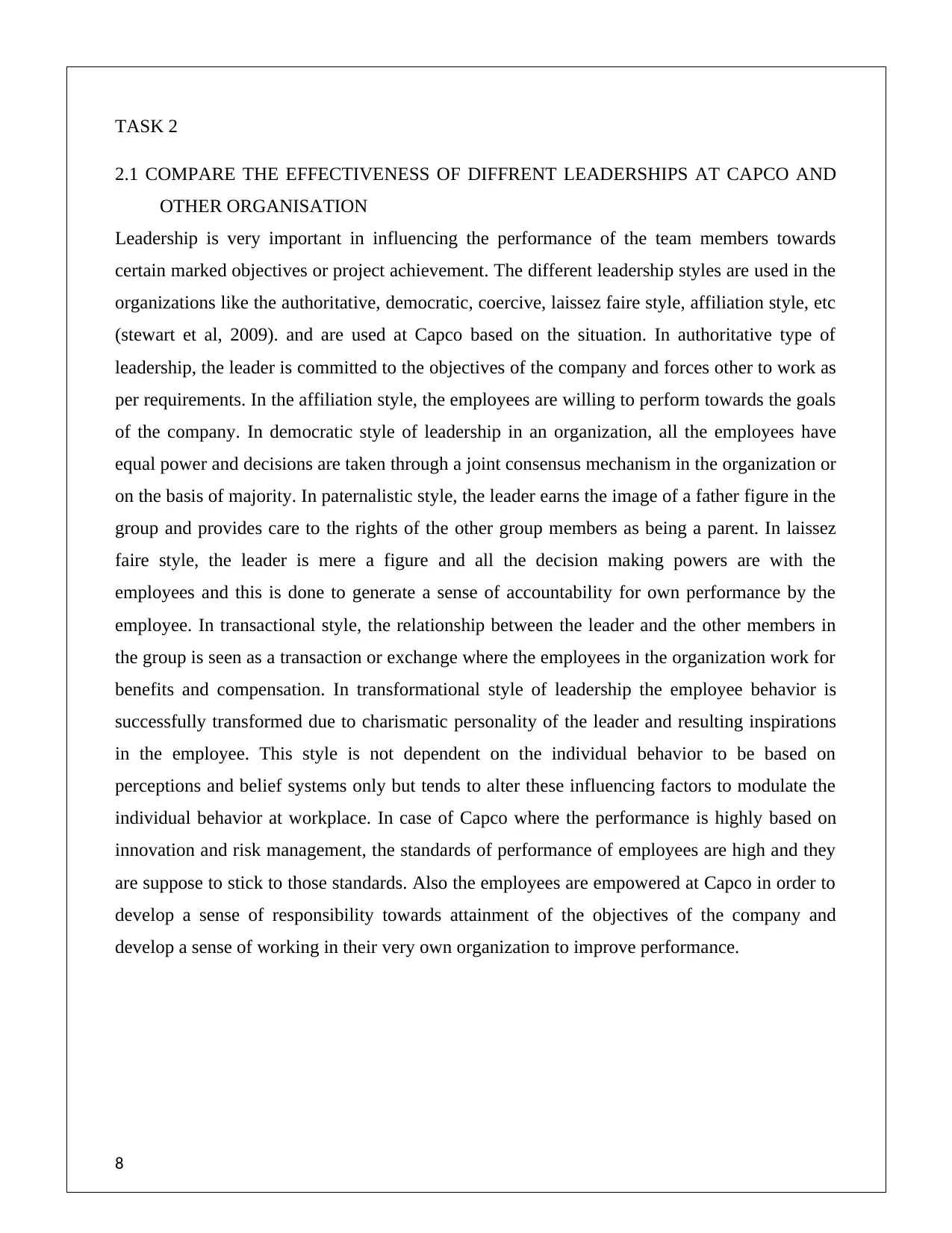
TASK 2
2.1 COMPARE THE EFFECTIVENESS OF DIFFRENT LEADERSHIPS AT CAPCO AND
OTHER ORGANISATION
Leadership is very important in influencing the performance of the team members towards
certain marked objectives or project achievement. The different leadership styles are used in the
organizations like the authoritative, democratic, coercive, laissez faire style, affiliation style, etc
(stewart et al, 2009). and are used at Capco based on the situation. In authoritative type of
leadership, the leader is committed to the objectives of the company and forces other to work as
per requirements. In the affiliation style, the employees are willing to perform towards the goals
of the company. In democratic style of leadership in an organization, all the employees have
equal power and decisions are taken through a joint consensus mechanism in the organization or
on the basis of majority. In paternalistic style, the leader earns the image of a father figure in the
group and provides care to the rights of the other group members as being a parent. In laissez
faire style, the leader is mere a figure and all the decision making powers are with the
employees and this is done to generate a sense of accountability for own performance by the
employee. In transactional style, the relationship between the leader and the other members in
the group is seen as a transaction or exchange where the employees in the organization work for
benefits and compensation. In transformational style of leadership the employee behavior is
successfully transformed due to charismatic personality of the leader and resulting inspirations
in the employee. This style is not dependent on the individual behavior to be based on
perceptions and belief systems only but tends to alter these influencing factors to modulate the
individual behavior at workplace. In case of Capco where the performance is highly based on
innovation and risk management, the standards of performance of employees are high and they
are suppose to stick to those standards. Also the employees are empowered at Capco in order to
develop a sense of responsibility towards attainment of the objectives of the company and
develop a sense of working in their very own organization to improve performance.
8
2.1 COMPARE THE EFFECTIVENESS OF DIFFRENT LEADERSHIPS AT CAPCO AND
OTHER ORGANISATION
Leadership is very important in influencing the performance of the team members towards
certain marked objectives or project achievement. The different leadership styles are used in the
organizations like the authoritative, democratic, coercive, laissez faire style, affiliation style, etc
(stewart et al, 2009). and are used at Capco based on the situation. In authoritative type of
leadership, the leader is committed to the objectives of the company and forces other to work as
per requirements. In the affiliation style, the employees are willing to perform towards the goals
of the company. In democratic style of leadership in an organization, all the employees have
equal power and decisions are taken through a joint consensus mechanism in the organization or
on the basis of majority. In paternalistic style, the leader earns the image of a father figure in the
group and provides care to the rights of the other group members as being a parent. In laissez
faire style, the leader is mere a figure and all the decision making powers are with the
employees and this is done to generate a sense of accountability for own performance by the
employee. In transactional style, the relationship between the leader and the other members in
the group is seen as a transaction or exchange where the employees in the organization work for
benefits and compensation. In transformational style of leadership the employee behavior is
successfully transformed due to charismatic personality of the leader and resulting inspirations
in the employee. This style is not dependent on the individual behavior to be based on
perceptions and belief systems only but tends to alter these influencing factors to modulate the
individual behavior at workplace. In case of Capco where the performance is highly based on
innovation and risk management, the standards of performance of employees are high and they
are suppose to stick to those standards. Also the employees are empowered at Capco in order to
develop a sense of responsibility towards attainment of the objectives of the company and
develop a sense of working in their very own organization to improve performance.
8
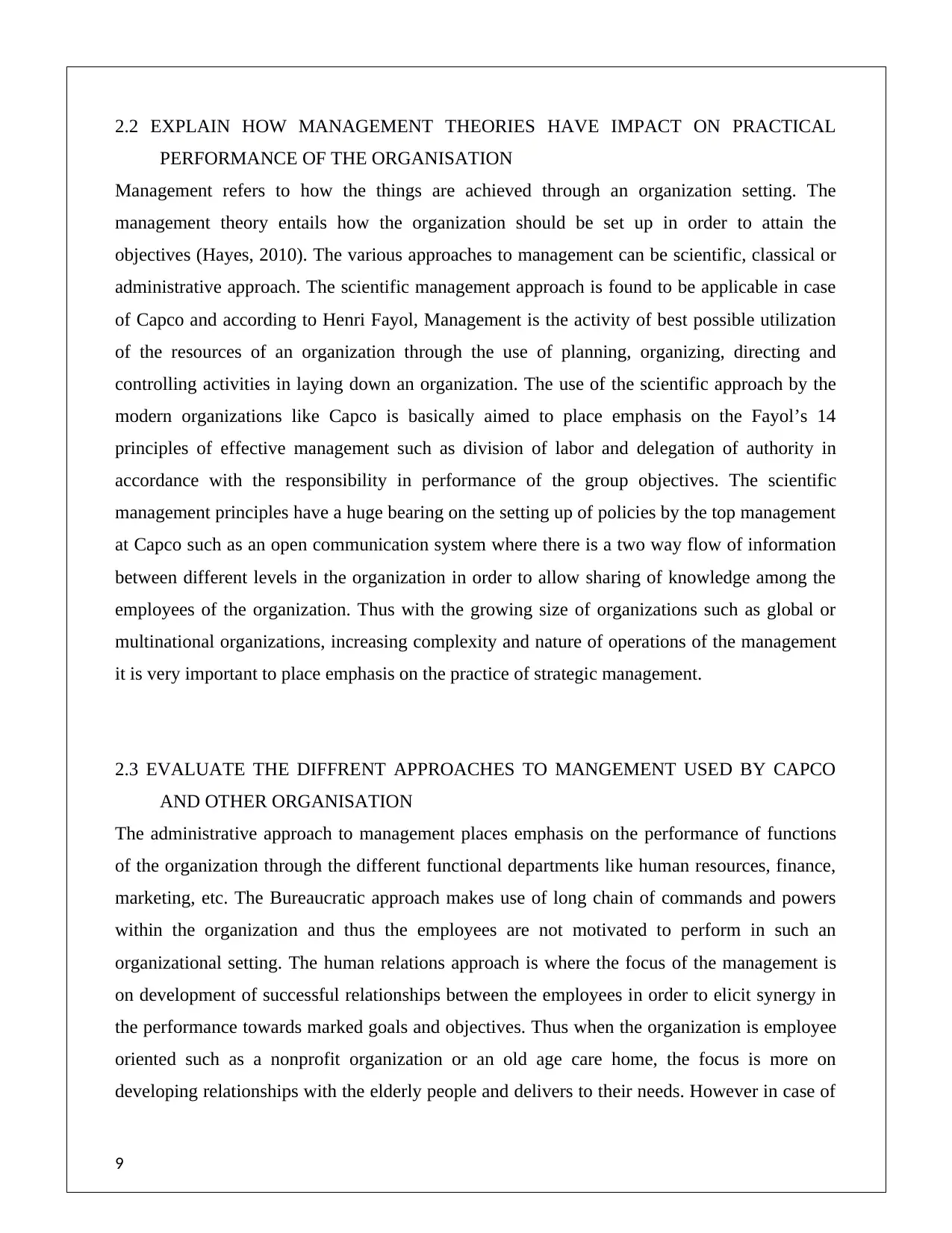
2.2 EXPLAIN HOW MANAGEMENT THEORIES HAVE IMPACT ON PRACTICAL
PERFORMANCE OF THE ORGANISATION
Management refers to how the things are achieved through an organization setting. The
management theory entails how the organization should be set up in order to attain the
objectives (Hayes, 2010). The various approaches to management can be scientific, classical or
administrative approach. The scientific management approach is found to be applicable in case
of Capco and according to Henri Fayol, Management is the activity of best possible utilization
of the resources of an organization through the use of planning, organizing, directing and
controlling activities in laying down an organization. The use of the scientific approach by the
modern organizations like Capco is basically aimed to place emphasis on the Fayol’s 14
principles of effective management such as division of labor and delegation of authority in
accordance with the responsibility in performance of the group objectives. The scientific
management principles have a huge bearing on the setting up of policies by the top management
at Capco such as an open communication system where there is a two way flow of information
between different levels in the organization in order to allow sharing of knowledge among the
employees of the organization. Thus with the growing size of organizations such as global or
multinational organizations, increasing complexity and nature of operations of the management
it is very important to place emphasis on the practice of strategic management.
2.3 EVALUATE THE DIFFRENT APPROACHES TO MANGEMENT USED BY CAPCO
AND OTHER ORGANISATION
The administrative approach to management places emphasis on the performance of functions
of the organization through the different functional departments like human resources, finance,
marketing, etc. The Bureaucratic approach makes use of long chain of commands and powers
within the organization and thus the employees are not motivated to perform in such an
organizational setting. The human relations approach is where the focus of the management is
on development of successful relationships between the employees in order to elicit synergy in
the performance towards marked goals and objectives. Thus when the organization is employee
oriented such as a nonprofit organization or an old age care home, the focus is more on
developing relationships with the elderly people and delivers to their needs. However in case of
9
PERFORMANCE OF THE ORGANISATION
Management refers to how the things are achieved through an organization setting. The
management theory entails how the organization should be set up in order to attain the
objectives (Hayes, 2010). The various approaches to management can be scientific, classical or
administrative approach. The scientific management approach is found to be applicable in case
of Capco and according to Henri Fayol, Management is the activity of best possible utilization
of the resources of an organization through the use of planning, organizing, directing and
controlling activities in laying down an organization. The use of the scientific approach by the
modern organizations like Capco is basically aimed to place emphasis on the Fayol’s 14
principles of effective management such as division of labor and delegation of authority in
accordance with the responsibility in performance of the group objectives. The scientific
management principles have a huge bearing on the setting up of policies by the top management
at Capco such as an open communication system where there is a two way flow of information
between different levels in the organization in order to allow sharing of knowledge among the
employees of the organization. Thus with the growing size of organizations such as global or
multinational organizations, increasing complexity and nature of operations of the management
it is very important to place emphasis on the practice of strategic management.
2.3 EVALUATE THE DIFFRENT APPROACHES TO MANGEMENT USED BY CAPCO
AND OTHER ORGANISATION
The administrative approach to management places emphasis on the performance of functions
of the organization through the different functional departments like human resources, finance,
marketing, etc. The Bureaucratic approach makes use of long chain of commands and powers
within the organization and thus the employees are not motivated to perform in such an
organizational setting. The human relations approach is where the focus of the management is
on development of successful relationships between the employees in order to elicit synergy in
the performance towards marked goals and objectives. Thus when the organization is employee
oriented such as a nonprofit organization or an old age care home, the focus is more on
developing relationships with the elderly people and delivers to their needs. However in case of
9
⊘ This is a preview!⊘
Do you want full access?
Subscribe today to unlock all pages.

Trusted by 1+ million students worldwide
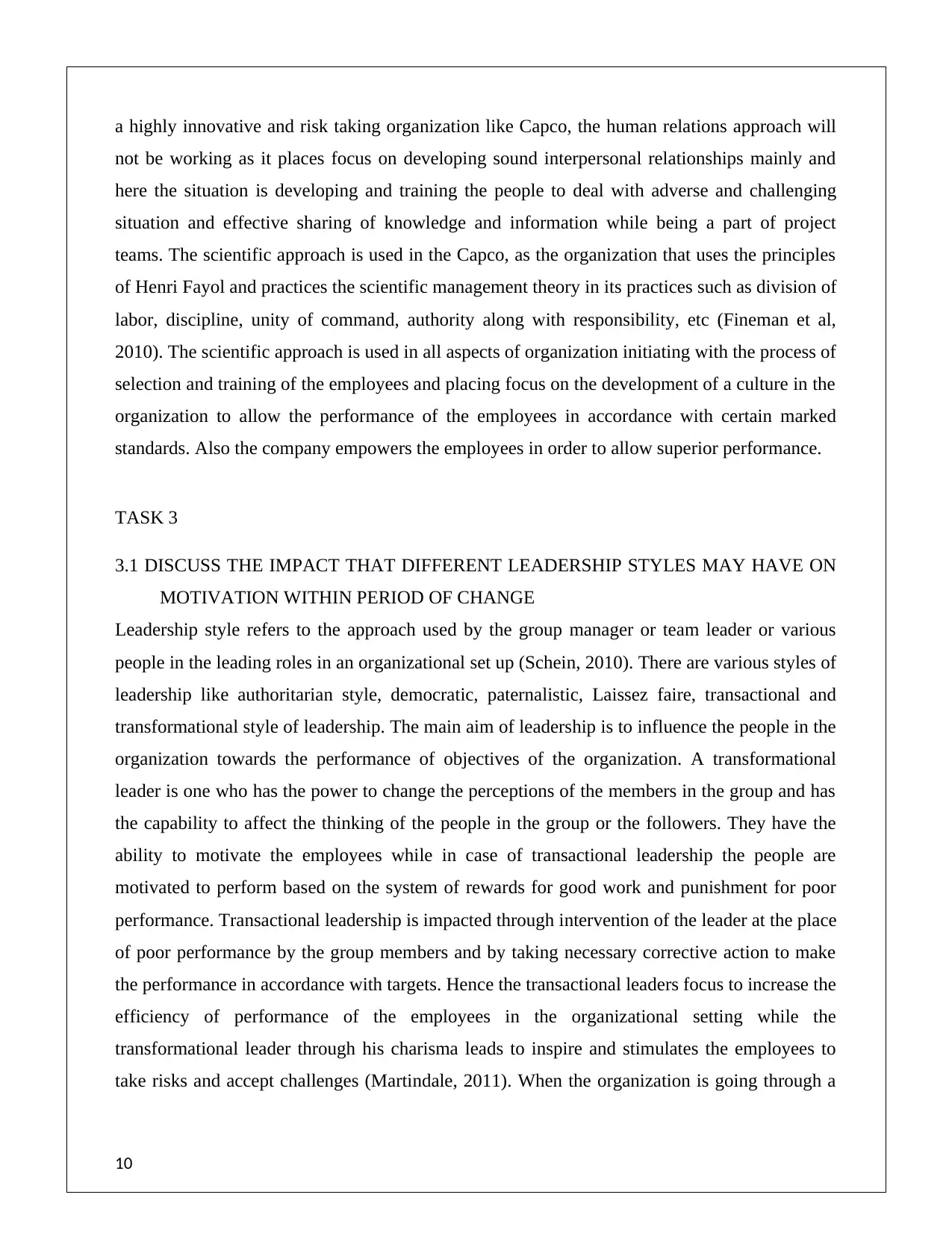
a highly innovative and risk taking organization like Capco, the human relations approach will
not be working as it places focus on developing sound interpersonal relationships mainly and
here the situation is developing and training the people to deal with adverse and challenging
situation and effective sharing of knowledge and information while being a part of project
teams. The scientific approach is used in the Capco, as the organization that uses the principles
of Henri Fayol and practices the scientific management theory in its practices such as division of
labor, discipline, unity of command, authority along with responsibility, etc (Fineman et al,
2010). The scientific approach is used in all aspects of organization initiating with the process of
selection and training of the employees and placing focus on the development of a culture in the
organization to allow the performance of the employees in accordance with certain marked
standards. Also the company empowers the employees in order to allow superior performance.
TASK 3
3.1 DISCUSS THE IMPACT THAT DIFFERENT LEADERSHIP STYLES MAY HAVE ON
MOTIVATION WITHIN PERIOD OF CHANGE
Leadership style refers to the approach used by the group manager or team leader or various
people in the leading roles in an organizational set up (Schein, 2010). There are various styles of
leadership like authoritarian style, democratic, paternalistic, Laissez faire, transactional and
transformational style of leadership. The main aim of leadership is to influence the people in the
organization towards the performance of objectives of the organization. A transformational
leader is one who has the power to change the perceptions of the members in the group and has
the capability to affect the thinking of the people in the group or the followers. They have the
ability to motivate the employees while in case of transactional leadership the people are
motivated to perform based on the system of rewards for good work and punishment for poor
performance. Transactional leadership is impacted through intervention of the leader at the place
of poor performance by the group members and by taking necessary corrective action to make
the performance in accordance with targets. Hence the transactional leaders focus to increase the
efficiency of performance of the employees in the organizational setting while the
transformational leader through his charisma leads to inspire and stimulates the employees to
take risks and accept challenges (Martindale, 2011). When the organization is going through a
10
not be working as it places focus on developing sound interpersonal relationships mainly and
here the situation is developing and training the people to deal with adverse and challenging
situation and effective sharing of knowledge and information while being a part of project
teams. The scientific approach is used in the Capco, as the organization that uses the principles
of Henri Fayol and practices the scientific management theory in its practices such as division of
labor, discipline, unity of command, authority along with responsibility, etc (Fineman et al,
2010). The scientific approach is used in all aspects of organization initiating with the process of
selection and training of the employees and placing focus on the development of a culture in the
organization to allow the performance of the employees in accordance with certain marked
standards. Also the company empowers the employees in order to allow superior performance.
TASK 3
3.1 DISCUSS THE IMPACT THAT DIFFERENT LEADERSHIP STYLES MAY HAVE ON
MOTIVATION WITHIN PERIOD OF CHANGE
Leadership style refers to the approach used by the group manager or team leader or various
people in the leading roles in an organizational set up (Schein, 2010). There are various styles of
leadership like authoritarian style, democratic, paternalistic, Laissez faire, transactional and
transformational style of leadership. The main aim of leadership is to influence the people in the
organization towards the performance of objectives of the organization. A transformational
leader is one who has the power to change the perceptions of the members in the group and has
the capability to affect the thinking of the people in the group or the followers. They have the
ability to motivate the employees while in case of transactional leadership the people are
motivated to perform based on the system of rewards for good work and punishment for poor
performance. Transactional leadership is impacted through intervention of the leader at the place
of poor performance by the group members and by taking necessary corrective action to make
the performance in accordance with targets. Hence the transactional leaders focus to increase the
efficiency of performance of the employees in the organizational setting while the
transformational leader through his charisma leads to inspire and stimulates the employees to
take risks and accept challenges (Martindale, 2011). When the organization is going through a
10
Paraphrase This Document
Need a fresh take? Get an instant paraphrase of this document with our AI Paraphraser
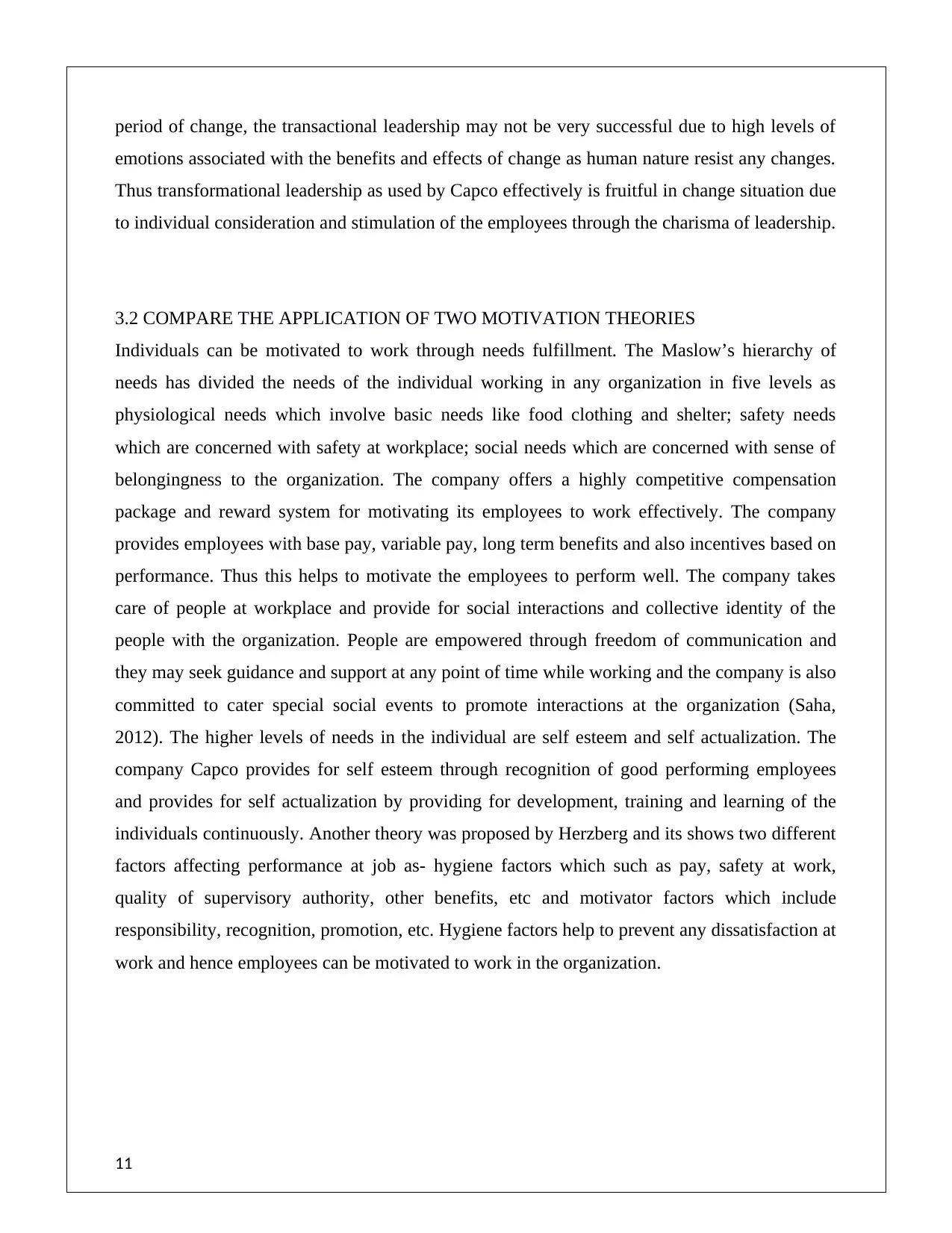
period of change, the transactional leadership may not be very successful due to high levels of
emotions associated with the benefits and effects of change as human nature resist any changes.
Thus transformational leadership as used by Capco effectively is fruitful in change situation due
to individual consideration and stimulation of the employees through the charisma of leadership.
3.2 COMPARE THE APPLICATION OF TWO MOTIVATION THEORIES
Individuals can be motivated to work through needs fulfillment. The Maslow’s hierarchy of
needs has divided the needs of the individual working in any organization in five levels as
physiological needs which involve basic needs like food clothing and shelter; safety needs
which are concerned with safety at workplace; social needs which are concerned with sense of
belongingness to the organization. The company offers a highly competitive compensation
package and reward system for motivating its employees to work effectively. The company
provides employees with base pay, variable pay, long term benefits and also incentives based on
performance. Thus this helps to motivate the employees to perform well. The company takes
care of people at workplace and provide for social interactions and collective identity of the
people with the organization. People are empowered through freedom of communication and
they may seek guidance and support at any point of time while working and the company is also
committed to cater special social events to promote interactions at the organization (Saha,
2012). The higher levels of needs in the individual are self esteem and self actualization. The
company Capco provides for self esteem through recognition of good performing employees
and provides for self actualization by providing for development, training and learning of the
individuals continuously. Another theory was proposed by Herzberg and its shows two different
factors affecting performance at job as- hygiene factors which such as pay, safety at work,
quality of supervisory authority, other benefits, etc and motivator factors which include
responsibility, recognition, promotion, etc. Hygiene factors help to prevent any dissatisfaction at
work and hence employees can be motivated to work in the organization.
11
emotions associated with the benefits and effects of change as human nature resist any changes.
Thus transformational leadership as used by Capco effectively is fruitful in change situation due
to individual consideration and stimulation of the employees through the charisma of leadership.
3.2 COMPARE THE APPLICATION OF TWO MOTIVATION THEORIES
Individuals can be motivated to work through needs fulfillment. The Maslow’s hierarchy of
needs has divided the needs of the individual working in any organization in five levels as
physiological needs which involve basic needs like food clothing and shelter; safety needs
which are concerned with safety at workplace; social needs which are concerned with sense of
belongingness to the organization. The company offers a highly competitive compensation
package and reward system for motivating its employees to work effectively. The company
provides employees with base pay, variable pay, long term benefits and also incentives based on
performance. Thus this helps to motivate the employees to perform well. The company takes
care of people at workplace and provide for social interactions and collective identity of the
people with the organization. People are empowered through freedom of communication and
they may seek guidance and support at any point of time while working and the company is also
committed to cater special social events to promote interactions at the organization (Saha,
2012). The higher levels of needs in the individual are self esteem and self actualization. The
company Capco provides for self esteem through recognition of good performing employees
and provides for self actualization by providing for development, training and learning of the
individuals continuously. Another theory was proposed by Herzberg and its shows two different
factors affecting performance at job as- hygiene factors which such as pay, safety at work,
quality of supervisory authority, other benefits, etc and motivator factors which include
responsibility, recognition, promotion, etc. Hygiene factors help to prevent any dissatisfaction at
work and hence employees can be motivated to work in the organization.
11
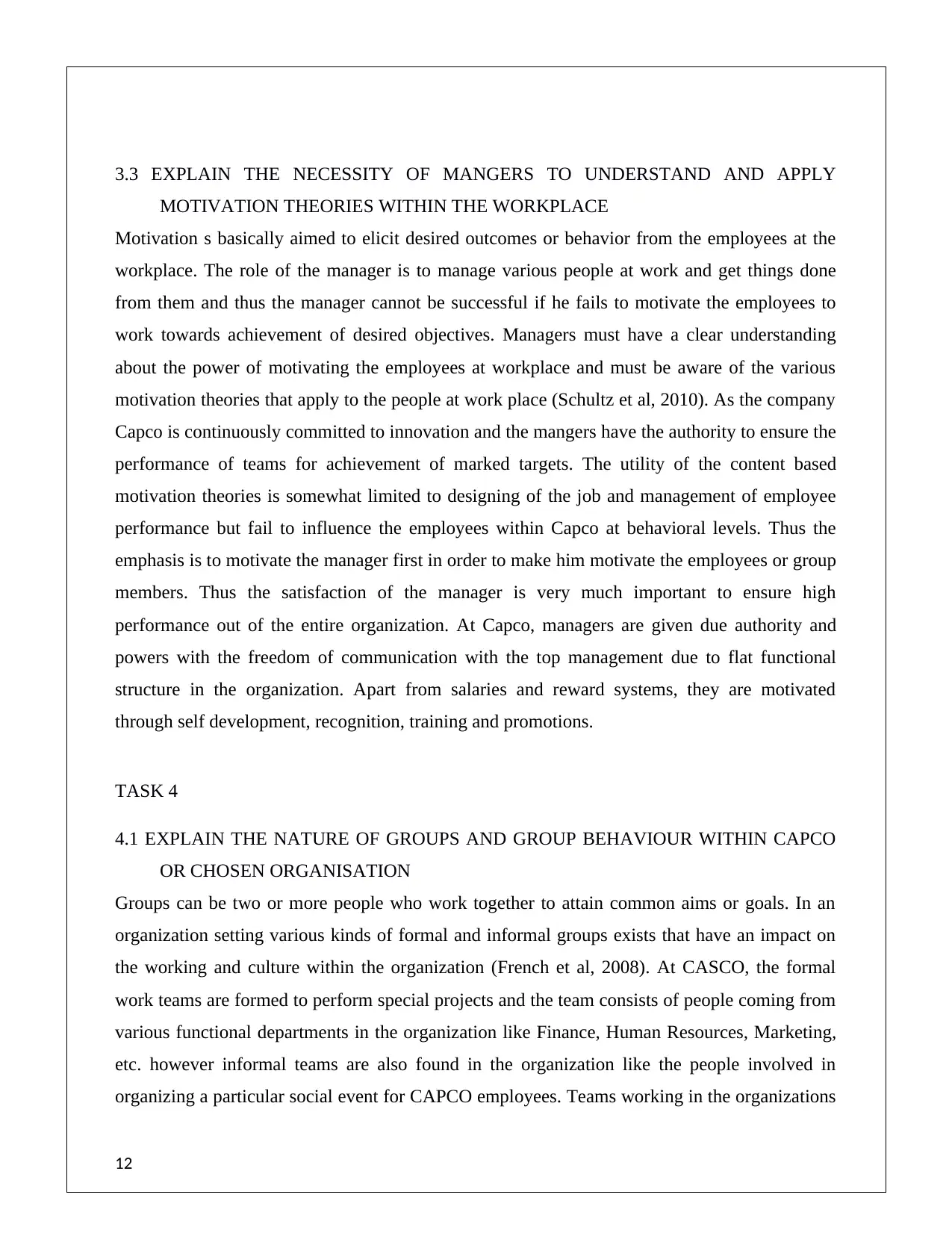
3.3 EXPLAIN THE NECESSITY OF MANGERS TO UNDERSTAND AND APPLY
MOTIVATION THEORIES WITHIN THE WORKPLACE
Motivation s basically aimed to elicit desired outcomes or behavior from the employees at the
workplace. The role of the manager is to manage various people at work and get things done
from them and thus the manager cannot be successful if he fails to motivate the employees to
work towards achievement of desired objectives. Managers must have a clear understanding
about the power of motivating the employees at workplace and must be aware of the various
motivation theories that apply to the people at work place (Schultz et al, 2010). As the company
Capco is continuously committed to innovation and the mangers have the authority to ensure the
performance of teams for achievement of marked targets. The utility of the content based
motivation theories is somewhat limited to designing of the job and management of employee
performance but fail to influence the employees within Capco at behavioral levels. Thus the
emphasis is to motivate the manager first in order to make him motivate the employees or group
members. Thus the satisfaction of the manager is very much important to ensure high
performance out of the entire organization. At Capco, managers are given due authority and
powers with the freedom of communication with the top management due to flat functional
structure in the organization. Apart from salaries and reward systems, they are motivated
through self development, recognition, training and promotions.
TASK 4
4.1 EXPLAIN THE NATURE OF GROUPS AND GROUP BEHAVIOUR WITHIN CAPCO
OR CHOSEN ORGANISATION
Groups can be two or more people who work together to attain common aims or goals. In an
organization setting various kinds of formal and informal groups exists that have an impact on
the working and culture within the organization (French et al, 2008). At CASCO, the formal
work teams are formed to perform special projects and the team consists of people coming from
various functional departments in the organization like Finance, Human Resources, Marketing,
etc. however informal teams are also found in the organization like the people involved in
organizing a particular social event for CAPCO employees. Teams working in the organizations
12
MOTIVATION THEORIES WITHIN THE WORKPLACE
Motivation s basically aimed to elicit desired outcomes or behavior from the employees at the
workplace. The role of the manager is to manage various people at work and get things done
from them and thus the manager cannot be successful if he fails to motivate the employees to
work towards achievement of desired objectives. Managers must have a clear understanding
about the power of motivating the employees at workplace and must be aware of the various
motivation theories that apply to the people at work place (Schultz et al, 2010). As the company
Capco is continuously committed to innovation and the mangers have the authority to ensure the
performance of teams for achievement of marked targets. The utility of the content based
motivation theories is somewhat limited to designing of the job and management of employee
performance but fail to influence the employees within Capco at behavioral levels. Thus the
emphasis is to motivate the manager first in order to make him motivate the employees or group
members. Thus the satisfaction of the manager is very much important to ensure high
performance out of the entire organization. At Capco, managers are given due authority and
powers with the freedom of communication with the top management due to flat functional
structure in the organization. Apart from salaries and reward systems, they are motivated
through self development, recognition, training and promotions.
TASK 4
4.1 EXPLAIN THE NATURE OF GROUPS AND GROUP BEHAVIOUR WITHIN CAPCO
OR CHOSEN ORGANISATION
Groups can be two or more people who work together to attain common aims or goals. In an
organization setting various kinds of formal and informal groups exists that have an impact on
the working and culture within the organization (French et al, 2008). At CASCO, the formal
work teams are formed to perform special projects and the team consists of people coming from
various functional departments in the organization like Finance, Human Resources, Marketing,
etc. however informal teams are also found in the organization like the people involved in
organizing a particular social event for CAPCO employees. Teams working in the organizations
12
⊘ This is a preview!⊘
Do you want full access?
Subscribe today to unlock all pages.

Trusted by 1+ million students worldwide
1 out of 18
Related Documents
Your All-in-One AI-Powered Toolkit for Academic Success.
+13062052269
info@desklib.com
Available 24*7 on WhatsApp / Email
![[object Object]](/_next/static/media/star-bottom.7253800d.svg)
Unlock your academic potential
Copyright © 2020–2025 A2Z Services. All Rights Reserved. Developed and managed by ZUCOL.





